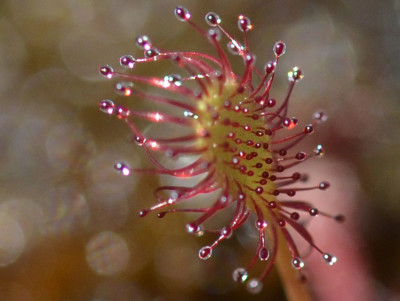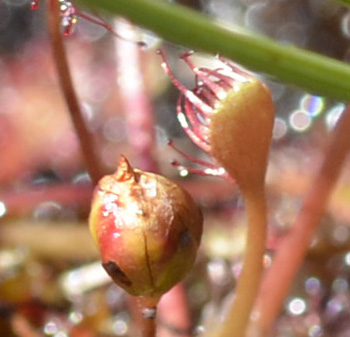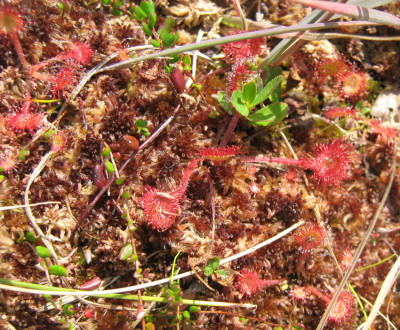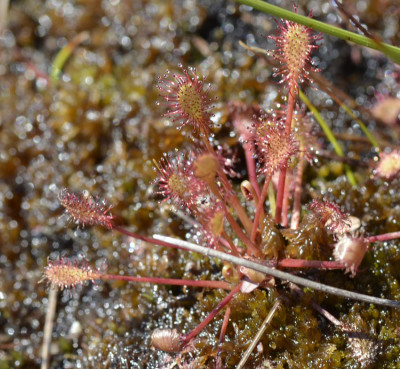As a child I found the carnivorous plants both intriguing and scary. As an adult I admit I am still a bit fascinated by them and I look for them each time I visit a bog. I hadn’t really tried to learn anything about Sundews or Pitcher Plants, though, until I decided to share a few photos from our last trip to Peggy’s Cove. Some simple research around the internet taught me a few new facts about the secrets of Sundews that I thought I’d share.
How Do Sundews Eat Insects?
Unlike my research into Pitcher Plants that turned up a complex food web lurking within the tubular leaves of the Northern Pitcher Plant, the Sundew seems much more straight forward.
The many tiny “tentacles” Sundews grow on their insect-eating leaves are very obvious when you glance at the plants. These plants then secrete a sticky sap that forms tiny beads along and at the tip of each red thread.
Insects who brush against the sap can get stuck. If in their struggles they brush against more tendrils they get more firmly trapped. To make matters worse, for the insect, the “tentacles” can actually move. They slowly fold in around the disturbance, gradually enclosing it.
To the back you can see a closed leaf. I believe the pod at the front is a seed pod.
Once trapped against the leaf, the insect is “digested” by enzymes secreted by the leaves. When the plant decides it’s “done” it unfolds. The dried exoskeleton of the insect eventually drops off or blows away.
According to the Encyclopedia of Life the sap itself is attractive to insects because it has sugar in it. The red colour of the “tentacles” may also attract some interest.
Commonly caught insects include flies, mosquitoes, gnats and some small butterflies and moths.
Who Exactly Do Sundews Catch Insects For: Themselves or Others?
Well, it’s not totally straight forward. A study by Martin Thum says that ants often steal and eat insects caught by the Sundews. His work shows that up to two thirds of the prey caught by Round Leaf Sundews are taken by ants. It’s not clear to me whether the ants provide any benefit to the plants.
Where Do Round Leaf Sundews Live?
According to various sources, Round Leaf Sundews are actually round the world Sundews. They are found in Europe, Siberia, Japan, and North America.
What Else Is Interesting about Round Leaf Sundews?
According to The Common Plants of the Muskegs of SouthEast Alaska, (see Figure 22 for this information), the Round Leaf Sundew contains an antibiotic effective against Streptococcus, Staphylococcus, and Pneumococcus bacteria. I have no idea whether that is accurate or how it has been tested but it was interesting to me!
Round Leaf Sundew
I also found it interesting that the plants “hibernate.” They form a tight ball of leaves at ground level to protect themselves against the winter cold.
According to the Victorian Carnivorous Plant Society (http://www.vcps.org/descriptions.html), Charles Darwin was fascinated by Round Leaf Sundews. They grew in England where he could study them.
What Other Sundews Grow In Nova Scotia?
As I described in Where Can I Find Pitcher Plants and Sundews Easily While On Vacation In Nova Scotia? one common Sundew that grows at Peggy’s Cove is the Round Leaf Sundew, Drosera rotundifolia. There is another one, too, the Spoon Leaf Sundew.
According to the Guide to the Atlantic Coastal Plain Flora of Nova Scotia by the Nova Scotia Nature Trust, the Spoon Leaf (or Spatula or Narrow Leaved) Sundew, Drosera Intermedia, also grows in Nova Scotia. The leaves of this plant are more oblong than round but otherwise it is very similar in appearance to the Round Leaf Sundew.
Spoon Leaf Sundew
The Thread-Leaved Sundew, Drosera filiformis, is a rare Sundew found in only a few patches in Nova Scotia. It is considered endangered.
All in all, I still find Sundews fascinating to study.
Related Reading
- How to Find Pitcher Plants and Sundews Easily In Nova Scotia
- What is Lurking in the Northern Pitcher Plant’s Pitchers?
Join In
Have you ever seen an insect get into a sticky situation with a Sundew? Please share your experiences with a comment.





